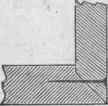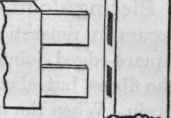Joiners' Joints. Part 7
Description
This section is from the book "A Practical Treatise On The Joints Made And Used By Builders", by Wyvill J. Christy. Also available from Amazon: Practical treatise on the joints made and used by builders.
Joiners' Joints. Part 7
Mitre Clamped Joint
Mitre Clamped Joint is made when a clamped joint is mitred as in Fig. 103.
Mitred Dovetail Joint
This is another name for the lapped and mitred dovetail, under which term a description is given. It is also designated secret dovetail.

Fig. 120.

Fig. 121.
Mitre Joint Keyed
Mitre Joint Keyed is a mitre strengthened with a slip feather inserted in opposite cross grooves in the butting edges, as in Fig. 122. The same term is applied to the joint in Fig. 123, where saw kerfs are drawn across its plane which are stopped with slips of hard wood coated with glue.
Mortise And Tenon Joint
This differs little from that described in the Carpenters' Section, being usually only smaller and cut and trimmed with more exactness, and sometimes not exceeding in thickness one-fourth that of the framing it secures. Moreover, instead of being fastened with a pin as explained under Pinned Joint in the same section, joiners now generally prefer to wedge up the tenon when inserted in the mortise with one or two small sharp wedges. Double tenons, represented in Fig. 124, usually lie in the same plane, and are advantageous in joinery, for consisting in reality of one wide tenon notched out in its central part to prevent bending, it requires less wood to be taken from the piece in making the mortises.
Nailed Joint
Besides those ordinarily formed, in fixing joiners' work, by the adhesion of the points of nails in wood slips, wood bricks, ranging bond, and specially made unbaked bricks, a good hold may be obtained in mortar joints by using long nails, or by inserting in the joints as the work is carried up doubled-over strips of lead or hoop iron so situated as to seize between the doubling the points of the nails.
Notched Joint
This is effected in many ways, the common dovetail, for instance, resulting from cutting notches in the edges of two boards in such a way that the notches in the one exactly correspond with the pins left between the notches in the other.

Fig. 122.

Fig. 123.

Fig. 124.
Open Joint occurs when the surfaces designed to be in contact show an intervening crevice. Tongues and rebates in floors, etc, diminish the mischief arising from joints opening by arresting dust and rays of light. To prevent open joints in skirtings, dados, etc, one edge or the middle only of work jointed together, but not framed, is fixed, the other or both, as the case may be, moving in a groove. On the whole, the usual open joints about a well-built but ill-ventilated building are probably more productive of good than harm in gradually replacing vitiated by purer air, and, in fact, acting in the aggregate as an old-fashioned unscientific, silent, and unseen ventilator.
Continue to:


